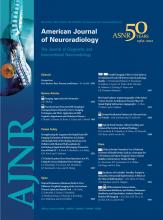Research ArticleNeurointervention
Effects of Flow-Diverting Device Oversizing on Hemodynamics Alteration in Cerebral Aneurysms
F. Mut and J.R. Cebral
American Journal of Neuroradiology November 2012, 33 (10) 2010-2016; DOI: https://doi.org/10.3174/ajnr.A3080
F. Mut
aFrom the Center for Computational Fluid Dynamics, College of Science, George Mason University, Fairfax, Virginia.
J.R. Cebral
aFrom the Center for Computational Fluid Dynamics, College of Science, George Mason University, Fairfax, Virginia.

References
- 1.↵
- Lylyk P,
- Ferrario A,
- Pasbon B,
- et al
- 2.↵
- 3.↵
- Szikora I,
- Berentei Z,
- Kulcsar Z,
- et al
- 4.↵
- Lylyk P,
- Miranda C,
- Ceratto R,
- et al
- 5.↵
- Szikora I,
- Berentei Z,
- Kulcsar Z,
- et al
- 6.↵
- Rayz VL,
- Boussel L,
- Lawton MT,
- et al
- 7.↵
- Cebral JR,
- Castro MA,
- Appanaboyina S,
- et al
- 8.↵
- Appanaboyina S,
- Mut F,
- Löhner R,
- et al
- 9.↵
- Mut F,
- Appanaboyina S,
- Cebral JR
- 10.↵
- Bathe KJ
- 11.↵
- 12.↵
- Cebral JR,
- Löhner R
- 13.↵
- 14.↵
- Murray CD
- 15.↵
- 16.↵
- Lieber BB,
- Stancampiano AP,
- Wakhloo AK
- 17.↵
- Aurboonyawat T,
- Blanc R,
- Schmidt P,
- et al
- 18.↵
- Mazumdar J
- 19.↵
In this issue
Advertisement
F. Mut, J.R. Cebral
Effects of Flow-Diverting Device Oversizing on Hemodynamics Alteration in Cerebral Aneurysms
American Journal of Neuroradiology Nov 2012, 33 (10) 2010-2016; DOI: 10.3174/ajnr.A3080
0 Responses
Jump to section
Related Articles
- No related articles found.
Cited By...
- Intraluminal Flow Diverter Design Primer for Neurointerventionalists
- Evaluation of Outcome Prediction of Flow Diversion for Intracranial Aneurysms
- Comparison of Pipeline Embolization Device Sizing Based on Conventional 2D Measurements and Virtual Simulation Using the Sim&Size Software: An Agreement Study
- Compacting a Single Flow Diverter versus Overlapping Flow Diverters for Intracranial Aneurysms: A Computational Study
- Virtual-versus-Real Implantation of Flow Diverters: Clinical Potential and Influence of Vascular Geometry
- Relationship between aneurysm occlusion and flow diverting device oversizing in a rabbit model
- Hemodynamic analysis of fast and slow aneurysm occlusions by flow diversion in rabbits
- Association between hemodynamic conditions and occlusion times after flow diversion in cerebral aneurysms
- Enhanced Aneurysmal Flow Diversion Using a Dynamic Push-Pull Technique: An Experimental and Modeling Study
- Effect of Structural Remodeling (Retraction and Recoil) of the Pipeline Embolization Device on Aneurysm Occlusion Rate
- Analysis of Hemodynamics and Aneurysm Occlusion after Flow-Diverting Treatment in Rabbit Models
- Building Multidevice Pipeline Constructs of Favorable Metal Coverage: A Practical Guide
- Variable Porosity of the Pipeline Embolization Device in Straight and Curved Vessels: A Guide for Optimal Deployment Strategy
- Cerebral Aneurysms Treated with Flow-Diverting Stents: Computational Models with Intravascular Blood Flow Measurements
- The Varying Porosity of Braided Self-Expanding Stents and Flow Diverters: An Experimental Study
This article has been cited by the following articles in journals that are participating in Crossref Cited-by Linking.
- M. Shapiro, E. Raz, T. Becske, P. K. NelsonAmerican Journal of Neuroradiology 2014 35 4
- Fernando Mut, Marcelo Raschi, Esteban Scrivano, Carlos Bleise, Jorge Chudyk, Rosana Ceratto, Pedro Lylyk, Juan R CebralJournal of NeuroInterventional Surgery 2015 7 4
- A. Makoyeva, F. Bing, T.E. Darsaut, I. Salazkin, J. RaymondAmerican Journal of Neuroradiology 2013 34 3
- M.R. Levitt, P.M. McGah, A. Aliseda, P.D. Mourad, J.D. Nerva, S.S. Vaidya, R.P. Morton, B.V. Ghodke, L.J. KimAmerican Journal of Neuroradiology 2014 35 1
- J. R. Cebral, F. Mut, M. Raschi, S. Hodis, Y.- H. Ding, B. J. Erickson, R. Kadirvel, D. F. KallmesAmerican Journal of Neuroradiology 2014 35 8
- M. Shapiro, E. Raz, T. Becske, P. K. NelsonAmerican Journal of Neuroradiology 2014 35 8
- Philipp Berg, Christina Iosif, Sebastien Ponsonnard, Catherine Yardin, Gábor Janiga, Charbel MounayerJournal of Biomechanics 2016 49 1
- D. Ma, J. Xiang, H. Choi, T. M. Dumont, S. K. Natarajan, A. H. Siddiqui, H. MengAmerican Journal of Neuroradiology 2014 35 9
- Fabrice Bing, Tim E. Darsaut, Igor Salazkin, Alina Makoyeva, Guylaine Gevry, Jean RaymondNeuroradiology 2013 55 1
- R.J. Damiano, V.M. Tutino, N. Paliwal, D. Ma, J.M. Davies, A.H. Siddiqui, H. MengAmerican Journal of Neuroradiology 2017 38 3
More in this TOC Section
Similar Articles
Advertisement











